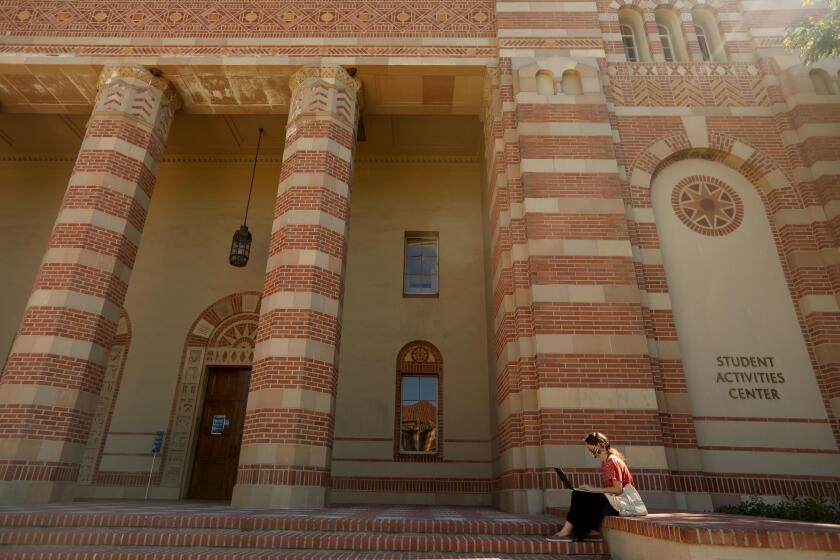San Diego park mural critical of a border wall called ‘anti-American’
- Share via
Reporting from San Diego — One of the first artists to paint in San Diego’s Chicano Park has finished a new mural, one depicting the plight of migrant workers and denouncing President Trump’s planned border wall.
Salvador “Sal” Barajas was part of a group of artists who painted the “Historical Mural” in the park in 1973 that features the leaders and history of the Chicano movement. While Barajas also worked on a restoration project for the park’s many murals several years ago, the new mural is the first time Barajas has put up his own work in the park since 1973.
Park enthusiasts are pleased with the new mural, on the south side of a pillar of the Coronado bridge.
But some who support Trump’s border wall are upset at the mural’s message.
Barajas’ latest piece was commissioned almost a decade ago by Border Angels, a migrant rights group known for putting water in the desert to keep border crossers from dying of thirst. This year, the nonprofit group finally had enough funding to make the mural a reality, at a cost of about $10,000.
The mural shows a worker sending money back to his family in Mexico while being strangled by two hands. One hand represents U.S. Immigration and Customs Enforcement, which is responsible for deporting people from the U.S. The other hand represents Mexican government officials, whose corruption makes it necessary for Mexicans to migrate for work, Barajas said.
We are minorities, and minorities have been oppressed for so long.
— Salvador “Sal” Barajas
The bottom of the piece pays homage to Roberto Martinez and Micaela Saucedo, two activists who worked with Border Angels. A large cross toward the bottom reads, “No Border Wall.” Another one carries a Border Angels slogan, “Love has no borders.”
The text “No Border Wall” was one of the last things added to the piece, Barajas said, though the overall message and image was largely the same as what was planned when Border Angels first commissioned the work.
“We are minorities, and minorities have been oppressed for so long,” Barajas said in an interview at the park. “We have to express our feelings. We have it in our DNA.”
Barajas was born in Mexico and sponsored by his father, who was living and working legally in the U.S., to move to San Diego when he was 17, he said. He talked about struggles with racial profiling, low wages and lack of resources that his community experienced as he came of age in Barrio Logan before joining the U.S. Air Force.
“When you’re a minority, you’re faced with realities like this all the time,” Barajas said.
Jesus Amaro, who lives in Mission Gorge, stood admiring the new mural at Chicano Park on Thursday while his daughter played on the playground. He brings her to Chicano Park often, he said, because he likes the community.
“It’s great work, especially for the community around here,” Amaro said when asked about the mural. “It’s a whole united message, everybody coming together and standing for everybody’s rights.”
All of the murals tell the stories about the history of the park’s community, he said, and he was happy to see one added that reflected current events.
Word of the mural has spread farther than Chicano Park, and some don’t welcome the artwork’s message. Patti Brasga, a Vista resident, received an email from a friend with a picture of the mural.
“These kinds of people and incendiary statements only serve to divide us and elevate the discord and hate,” she said via email.
Suellen Shea of Vista took issue with the imagery Barajas used. Shea hasn’t seen the mural in person but has seen pictures of it, she said.
“The artist has talent, but, in my opinion, much of it is offensive and anti-American, especially the ICE agent choking the migrant worker,” Shea said via email. “American Citizens want safety & sovereignty (enforced borders) for our country. Nothing strange or racist about that – Mexico does too.”
Several San Diegans who were bothered by the new mural, as well as other murals at the park, said they don’t think public parks should have art with political messages.
“San Diego has many parks,” wrote Carol Hamilton, an Imperial Beach resident who also received an email about the mural. “Only one is splattered with garish posters and anti-American slurs — Chicano Park. A national shrine? I don’t think so. It’s time to whitewash it and use it as a park and not for politics.”
The Chicano Park Steering Committee, a nonprofit, is responsible for approving any murals or other additions to the park. Neither the city nor the California Department of Transportation is involved, Barajas said, though Caltrans could step in if the department disapproved of a piece.
That committee was formed at the same time as the park was founded. Chicano Park was created when the Barrio Logan community, reeling from losing homes to make way for Interstate 5, gathered there in 1970 to stop the California Highway Patrol from building a patrol station under the Coronado Bridge.
Isidro Ortiz, a professor of Chicana and Chicano Studies at San Diego State University, said the act of claiming land for a park was in line with one of the principles of the Chicano movement — self-determination.
“The community has the right to determine its own destiny,” Ortiz said.
The Chicano movement, Ortiz said, was a way for people of Mexican origin living in the U.S. and coming of age in the 1960s to get a sense of identity.
“We were neither accepted as Americans nor accepted as Mexicans,” Ortiz said. “We were living in a twilight zone. It can be very confusing because you really don’t know who you are.”
Morrissey writes for the San Diego Union-Tribune.
ALSO
Trump wants immigrants to ‘share our values.’ They say assimilation is much more complex
More to Read
Sign up for Essential California
The most important California stories and recommendations in your inbox every morning.
You may occasionally receive promotional content from the Los Angeles Times.










